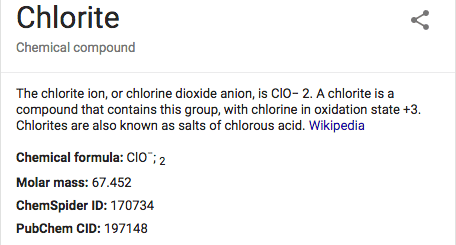Sodium Chlorite Water Purification
About Chlorite
Chlorine dioxide is a yellowish-green to reddish gas with an irritating odor that is water soluble and used in some water treatment plants. Chlorine dioxide reacts quickly when exposed to water, killing bacteria and producing by products.
Chlorite Ion is a compound with chlorine in oxidation state +3.
Chlorine Dioxide is a hazardous gas, so it is produced on location when needed for a process, such as paper making or water purification. When chlorine dioxide is used in water, Chlorite ion is a byproduct of that process. Chlorite is then present in small amounts in the tap water of cities that use chlorine dioxide in their water purification process.
How Does Chlorine Dioxide Gas Form Chlorite?
Also known as salts of chlorous acid, the chemical compound is a disinfection byproduct that occurs when chlorine dioxide breaks down during the chlorination process.
The water soluble gas form of chlorine dioxide is used in about 5% of water treatment plants in the United States. The chemical reaction between chlorine dioxide and water kills any bacteria and microorganisms in the water, but also produces chlorite ions and sodium ions as byproducts of the reaction.
Sodium Chlorite vs Sodium Chloride
Sodium Chlorite, also known as chlorous acid, sodium salt textone, and the “Miracle Mineral Solution,” is a toxic chemical used to disinfect and purify. It is used in the production of chlorine dioxide. One of the scary things about Sodium Chlorite is that it has been touted as a miracle health cure in the past, with nasty results of making many people sick and requiring the FDA to step in and try to save lives. If you’ve heard of people “drinking bleach”, these products would be why.
To make matters even more complicated, there’s only one letter difference between the toxic chemical disinfectant and common table salt. Sodium chloride (NaCl) is common table salt, but it is spelled with a D and not a T. Drinking salt water may improve your health – drinking bleaching agents will not.
Sodium Chlorite vs. Sodium Chlorate
Not to make things even more complicated, but it does actually get more confusing.
Let’s Recap:
Sodium Chlorite = Used to produce chlorine dioxide, which is a bleaching agent.
Sodium Chloride = table salt.
Sodium ChlorATE = Used to produce chlorine dioxide.
Only one of these is considered safe to consume.
It’s worth noting that sodium chlorite solutions are available for sale as water purification drops to add to any water you may feel as been contaminated. Using a sodium chlorite solution in drinking water as you travel is a commonly accepted way to avoid bacteria contamination.
With these options, you must be extremely careful to dilute solutions to the specified amounts. Chlorine dioxide treatment is also available as a drinking water disinfectant for camping and backpacking in an emergency.
What Types of Industrial Uses Does it Have?
Sodium chlorite is the most significant commercial chlorite used as a disinfectant and in the production of paper. It is used in the creation of chlorine dioxide for bleaching and disinfection.
Chlorite is an essential compound for disinfection at municipal water treatment plants. Unlike other chlorine used in water treatment, sodium chlorite is FDA approved.
How Does Chlorite Get into Your Drinking Water
Chlorite ion, like most chlorine compounds, is a disinfection byproduct in most municipal water systems.
To generate potable water in mass, water disinfection uses chemical technology to kill bacteria.
In general, the trace amounts of by products such as chlorite ions are not considered to have much of a negative environmental impact, and the concentrations allowed by the CDC and EPA are not considered to have negative health effects.
The principal methods of water purification used in the united states do, however, leave by products in the water that are known to have toxic effects if exposure reaches certain limits. These limits are set by studies showing major health issues like cancers and birth defects – but the symptoms that are not traced are the ones that build up over subsequent years of ongoing exposure.
What are the Health Effects Associated with Chlorite?
Drinking chlorite-contaminated water above the maximum contamination level (MCL) may have adverse effects on the nervous system of younger people and infants. Exposure to high levels of chlorite in drinking water may also affect the development of the fetus during pregnancy.
Chlorite may also cause people to experience anemia if exposed to large quantities of the compound for longer periods.
How Common is Chlorite in Water?
Just like with other chlorine, chlorite is a disinfection byproduct found in treated water systems. The chlorination process produces chlorite, and the residue remains in the water until it is removed.
What is the EPA’s Contamination Level Standards for Chlorite in Drinking Water?
The MCLG for chlorite in drinking water is set at 0.80 mg/L or 800 ppb. The EPA’s MCL is at 1.0 mg/L or 1 ppm.
What is the Best Reduction Media for Removing Chlorite from Drinking Water?
Modern water filtration systems are designed to remove the new generation of contaminants in tap water. Chlorite and other chemical compounds are removed from drinking water with the use of filter media like granular activated carbon (GAC).
An AquaOx filter system is equipped with premium activated carbon to eliminate contaminants from your drinking water. Keep the family safe by installing a whole house water filter system today!
| Chemical Names: | CHLORITE; Chlorite ion; Chlorite(1-); 14998-27-7; Chlorine dioxide ion(1-); Dioxidochlorate |
|---|---|
| Molecular Formula: | ClO2– |
| Molecular Weight: | 67.448 g/mol |
| InChI Key: | QBWCMBCROVPCKQ-UHFFFAOYSA-M |
| Substance Registry: | FDA UNII |
The chlorite ion is ClO2-. A chlorite (compound) is a compound that contains this group, with chlorine in oxidation state +3. Chlorites are also known as salts of chlorous acid.
Source: Human Metabolome Database (HMDB)
Record Name: Chlorite
URL: http://www.hmdb.ca/metabolites/HMDB0002077
Description: The Human Metabolome Database (HMDB) is a freely available electronic database containing detailed information about small molecule metabolites found in the human body.
CHLORITES, INORGANIC, N.O.S. is a crystalline solids or aqueous solutions of these solids. Solids are likely to be water soluble and are denser than water.
Source: CAMEO Chemicals
URL: https://cameochemicals.noaa.gov/chemical/2866









